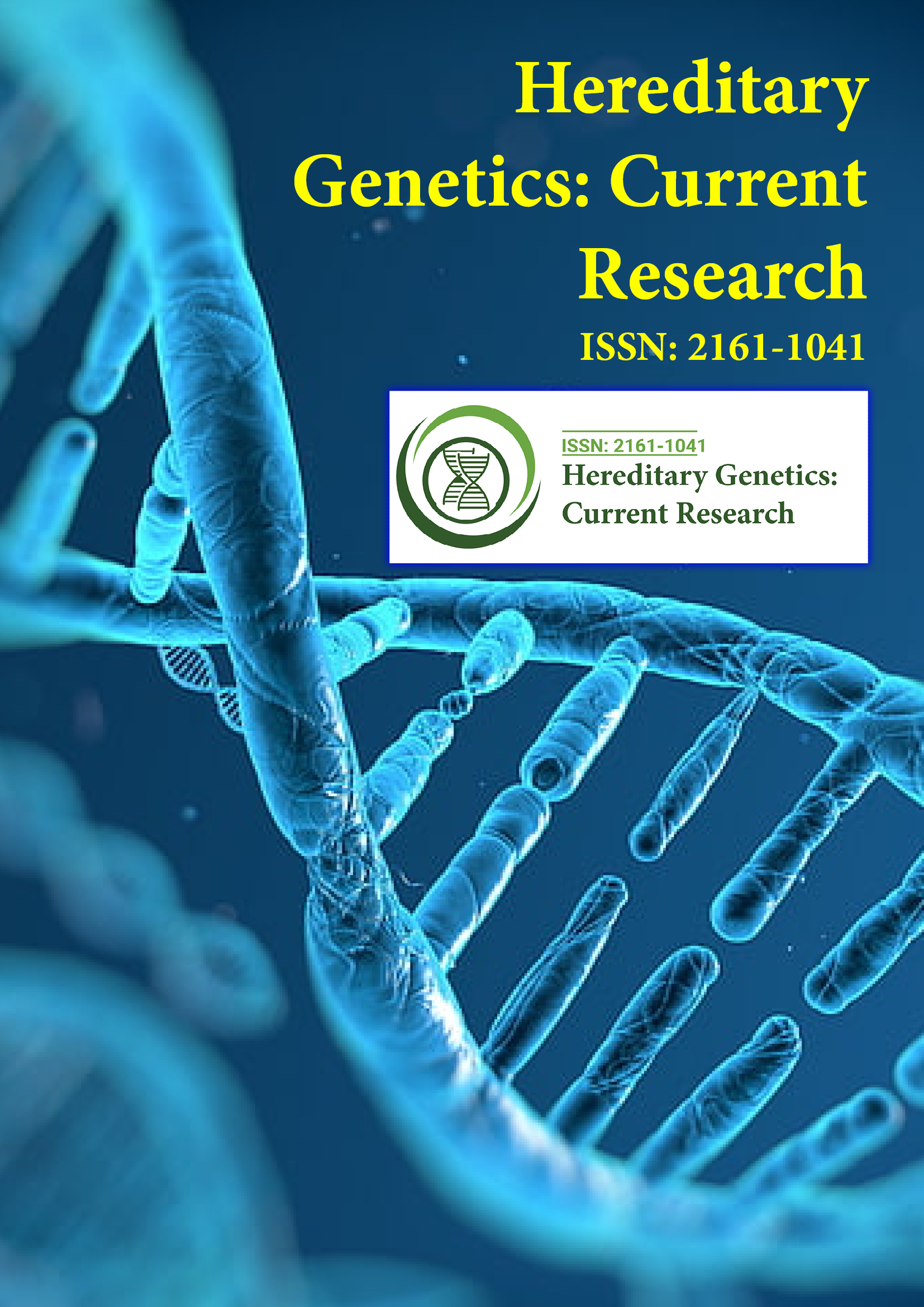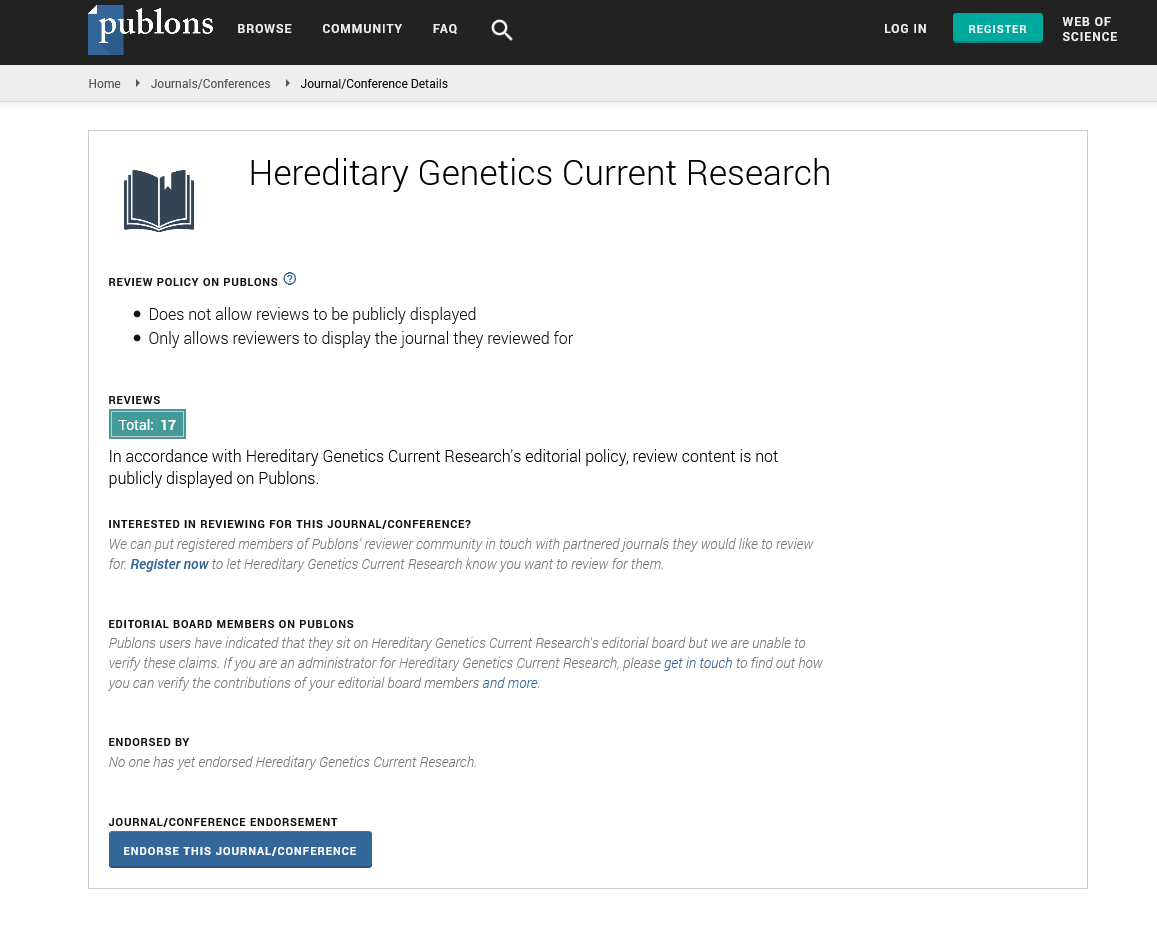Indexed In
- Open J Gate
- Genamics JournalSeek
- CiteFactor
- RefSeek
- Hamdard University
- EBSCO A-Z
- NSD - Norwegian Centre for Research Data
- OCLC- WorldCat
- Publons
- Geneva Foundation for Medical Education and Research
- Euro Pub
- Google Scholar
Useful Links
Share This Page
Journal Flyer

Open Access Journals
- Agri and Aquaculture
- Biochemistry
- Bioinformatics & Systems Biology
- Business & Management
- Chemistry
- Clinical Sciences
- Engineering
- Food & Nutrition
- General Science
- Genetics & Molecular Biology
- Immunology & Microbiology
- Medical Sciences
- Neuroscience & Psychology
- Nursing & Health Care
- Pharmaceutical Sciences
Commentary Article - (2022) Volume 11, Issue 6
Hereditary Condition of Cystic fibrosis (CF) and Its Chronic Infections
David Harris*Received: 04-Nov-2022, Manuscript No. HGCR-22-19018; Editor assigned: 07-Nov-2022, Pre QC No. HGCR-22-19018 (PQ); Reviewed: 21-Nov-2022, QC No. HGCR-22-19018; Revised: 28-Nov-2022, Manuscript No. HGCR-22-19018 (R); Published: 05-Dec-2022, DOI: 10.35248/2161-1041.22.11.227
Description
Cystic Fibrosis (CF) is a rare hereditary condition that mostly affects the lungs but can also affect the pancreas, liver, kidneys, and gut. Long-term effects of persistent lung infections include breathing difficulties and mucous coughing. Sinus infections, poor development, fatty stools, clubbing of the fingers and toes, and infertility in the majority of males are possible additional indications and symptoms. Symptoms might vary in severity between individuals. Autosomal recessive inheritance is how cystic fibrosis is transmitted. It is brought on by the presence of mutations in the Cystic Fibrosis Transmembrane Conductance Regulator (CFTR) protein gene in both copies of the cell. Those who only have one functioning copy are carriers and generally in good health. Sweat, digestive juices, and mucus are all produced thanks to CFTR. Secretions, which are typically thin, become thick when the CFTR is not working. Genetic tests and a sweat test are used to detect the illness. In several parts of the world, newborns are screened at the time of birth. For cystic fibrosis, there is no recognised treatment. Antibiotics that may be administered intravenously, breathed, or taken orally are used to treat lung infections. Long-term usage of the antibiotic azithromycin is occasionally necessary. Salbutamol and inhaled hypertonic saline may also be helpful. If lung function continues to decline, lung transplantation can be a possibility. Replacement of pancreatic enzymes and supplementation with fat-soluble vitamins are crucial, particularly in children. Techniques for clearing the airways, including chest physiotherapy, show some short-term benefits, but the long-term implications are not evident. 42 to 54 years is the typical life expectancy. In the developed countries, the average life expectancy is 42 to 50 years. 80% of cystic fibrosis patients die as a result of lung issues.
Chronic infections
People with cystic fibrosis develop bacterial colonisation and infection in their lungs at a young age. These bacteria grow in the altered mucus that builds up in the tiny airways of the lungs and is frequently contagious among CF patients. This mucus promotes the development of biofilms, which are tough for immune cells and drugs to penetrate and are bacterial microenvironments. By progressively redesigning the airways, viscous secretions and recurrent respiratory infections continuously harm the lungs, making it much more challenging to treat the illness. Due in large part to the enormous spatial and temporal heterogeneity both within and between the microbiomes of CF patients, the natural history of CF lung infections and airway remodelling is poorly understood. Bacteria's species and individual traits evolve over time in people with cystic fibrosis. Common bacteria including S aureus and H. influenza proliferate and infect the lungs in the first stage. Pseudomonas aeruginosa (and occasionally Burkholderia cepacia) eventually takes control. By the age of 18, P. aeruginosa is present in 80% of kids with typical CF and B. cepacia in 3.5%of patients. These bacteria adapt to their environment once they are inside the lungs and become resistant to standard antibiotics. Pseudomonas may acquire unique properties that enable the development of huge colonies, or "mucoid" Pseudomonas, which are hardly observed in individuals without CF. In instance, interleukin 17-mediated immunity has a double-edged role in the management of P. aeruginosa burden during chronic airway infection; on the one hand, it promotes increased pulmonary neutrophilia and tissue remodelling; on the other, it helps limit P. aeruginosa burden. By moving between different CF patients, infection might spread. In the past, CF patients frequently attended summer "camps" and other social events. Patients with cystic fibrosis were placed together in shared spaces in hospitals, and common equipment (such nebulizers) was not cleaned between patients. As a result, more harmful bacterial strains were spread throughout patient groups. In order to prevent the transmission of aggressive bacterial strains, healthcare professionals are advised to use gloves and gowns while examining patients with CF. As a result, people with CF are now regularly kept apart from one another in the hospital environment. Other filamentous fungi less frequently isolated include Aspergillus flavus and Aspergillus nidulans (occur transiently in CF respiratory secretions), Exophiala dermatitidis and Scedosporium prolificans (chronic airway-colonizers), and some filamentous fungi such as Penicillium aspergillus. CF patients may also have their airways chronically colonised by filamentous fungi (such as Local immunological problems are linked to the CF-specific defect in mucociliary clearance. Additionally, the use of corticosteroid medications and protracted antibiotic therapy may potentially promote fungal development. Filamentous fungi may contribute to the local inflammatory response and, consequently, to the progressive deterioration of lung function, as frequently happens with allergic bronchopulmonary aspergillosis, the most prevalent fungal disease in the context of cystic fibrosis (CF), involving a Th2-driven immune response to Aspergillus species. However, the clinical relevance of the fungal airway colonisation is still a matter of debate.
Citation: Harris D (2022) Hereditary Condition of Cystic Fibrosis (CF) and its Chronic Infections. Hereditary Genet. 11:227.
Copyright: © 2022 Harris D. This is an open-access article distributed under the terms of the Creative Commons Attribution License, which permits unrestricted use, distribution, and reproduction in any medium, provided the original author and source are credited.

